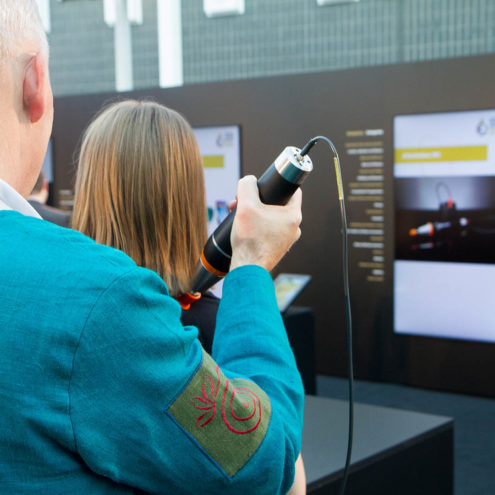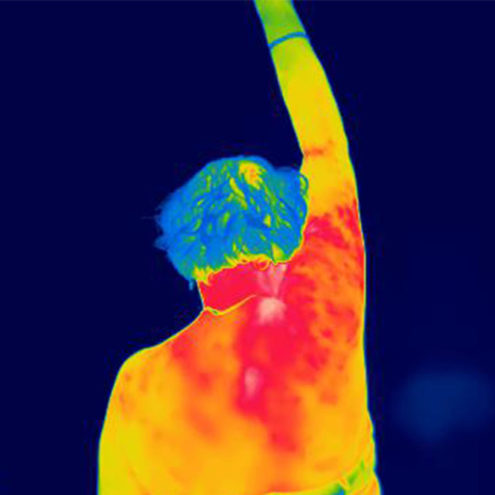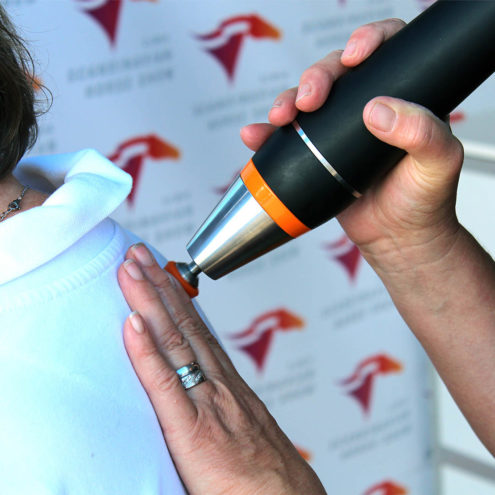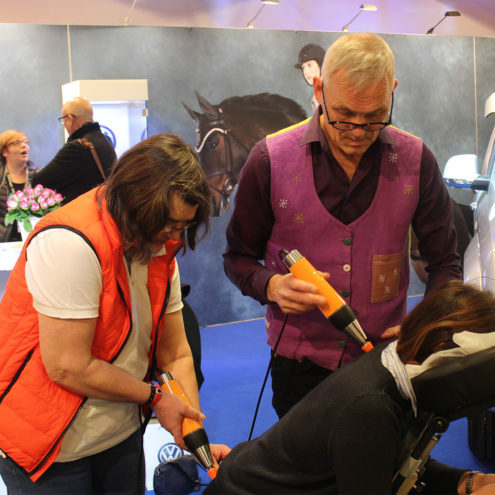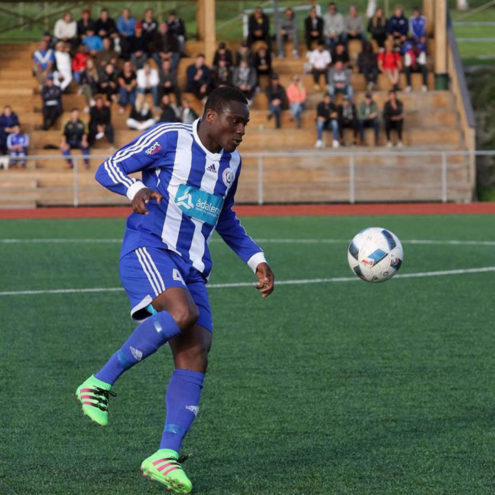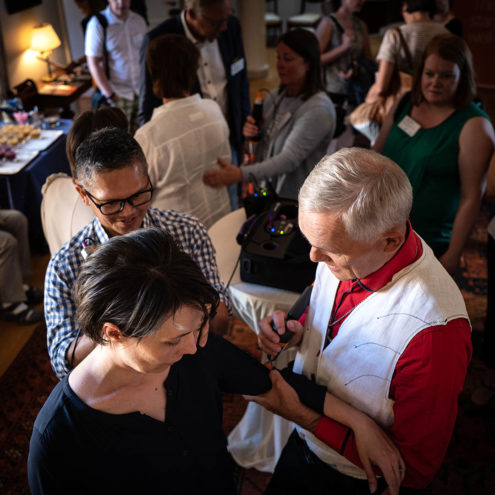Front Thigh Strain: Symptoms and Treatment

Front thigh strain is a common injury that often affects athletes and people who are physically active. The pain can be so severe that it limits everyday life. In this article, we will explore what a front thigh strain is, its causes, symptoms and how it can be treated. We will also discuss how the FasciaClinics can help you manage and rehabilitate this injury.
What is a front thigh strain?
Description of a front thigh strain, where the muscles of the front of the thigh are overstretched or injured
A front thigh strain means that one or more of the muscles that make up the quadriceps, which are found at the front of the thigh, have been overstretched or injured. The quadriceps muscles include the rectus femoris, vastus lateralis, vastus medialis and vastus intermedius. These muscles work together to extend the knee joint and flex the hip. When these muscles are overstretched or subjected to sudden loads, it can lead to small tears in the muscle fibers.
Common causes of front thigh strains, including overexertion, lack of warm-up or sudden movements
Frontal thigh strains can be caused by several factors:
Overstrain: Putting more strain on your muscles than they can handle can lead to strains. This is common in athletes who train intensively or don’t give their muscles enough rest between training sessions.
Lack of warm-up: Not warming up properly before physical activity can increase the risk of strains, as cold and stiff muscles are more prone to injury.
Sudden movements: Rapid changes in direction, explosive movements or sudden accelerations and decelerations can cause quadriceps strains
Symptoms of strain in the front of the thigh
Sharp pain or discomfort in the front of the thigh at the time of injury
The most immediate symptom of a front thigh strain is sharp pain or discomfort at the time of injury. The pain can be intense and may make it difficult to continue with the activity you were doing.
Swelling and tenderness in the injured area
After the injury, the area around the stretch may become swollen and tender. The swelling is due to inflammation and fluid accumulation in response to the injury. The area may also feel warm to the touch.
Limited mobility or difficulty stretching the leg or bending the hip
A strain in the front of the thigh may mean that movement in the leg is limited by the pain. It may be difficult to fully extend the leg or bend the hip without experiencing pain. This can affect your ability to walk, run or perform other activities that require the use of your legs.
Treatment of frontal thigh sprain
The R.I.C.E method (rest, ice, compression, elevation) to reduce pain and swelling after a stretch
The first treatment for a front thigh sprain is to apply the R.I.C.E method:
Rest: Take the weight off the injured leg and avoid activities that could aggravate the injury. Give the muscles time to heal by reducing physical activity.
Ice: Apply ice to the injured area for 15-20 minutes several times a day to reduce swelling and pain. Always use a towel or ice pack to avoid frostbite.
Compression: Use an elastic bandage to provide support and reduce swelling. Make sure the bandage is not too tight, which can restrict blood flow.
Elevation (Elevation): Keep the injured leg above the level of the heart as much as possible to reduce swelling.
Stretching and strengthening exercises to restore flexibility and strength in the front thigh muscles
After the initial inflammation phase, stretching and strengthening exercises can help restore flexibility and strength in the front thigh muscles. Some recommended exercises include:
Quadriceps stretch: Stand on one leg and pull your foot up towards your butt with your hand to stretch the front of your thigh. Hold for 20-30 seconds and repeat several times.
Hamstring stretch: Sit on the floor with your legs stretched straight out in front of you, reaching towards your toes to stretch the back of your thigh.
Light leg lifts: Lie on your back with one leg extended and the other bent. Lift the extended leg a few centimeters off the ground and hold for a few seconds before lowering it slowly. Repeat several times on both legs.
Gradual return to activity and sport after recovery to avoid relapse and improve muscle elasticity
Once the pain and swelling have decreased and mobility has improved, it is important to gradually return to activity. Start with light activities and gradually increase the intensity to avoid relapse. Focus on improving muscle elasticity and strength to reduce the risk of future injury.
How can we help you with your front thigh stretch?
Understanding the causes and symptoms is the first step towards finding effective relief. Our team of therapists uses fascia treatment to relieve tension and pain in our body. The fascia is the network of connective tissue that binds and permeates everything in our body. All cells, tissues (even bone tissue), muscles and organs contain fascia.
Fascia treatment focuses on releasing tension and adhesions in the fascia that can cause pain, stiffness and inflammation. By reducing tension in the fascia, we increase its flow. Among other things, this allows the cell membranes to more easily absorb nutrients and release waste products and also reduces pressure on our pain receptors. Muscles and joints soften, increasing the body’s mobility.
The treatment provides a pleasant relaxation and does not hurt. The entire body’s flow is activated and you are helped to balance your posture so that the body is evenly loaded.
During a visit, we analyze the whole body to see where compensations and imbalances are and how they have spread. If there is an imbalance in the body, there is a risk that it will spread and affect other structures such as muscles and joints. That’s why it’s very important to seek help quickly as soon as you notice any symptoms.
Fascia treatment for front thigh strain aims to balance the body by reducing the load on the anterior thigh so that the body weight is more evenly distributed on both legs. A more even load will reduce the wear and tear on muscles and other structures, speed up recovery from physical activity and reduce the risk of injury.
For more information about our services and how we can help you with a front thigh stretch, visit our website FasciaClinics. Here you will also find resources and articles on muscle injuries and other related topics that may be helpful to you.
In summary, a front thigh strain is a common and often painful injury that requires careful treatment and rehabilitation. By understanding the causes, symptoms and treatment methods, you can effectively manage and relieve your pain. At the FasciaClinics, we are here to support you every step of the way towards recovery and an active life without pain.
 Search
Search


